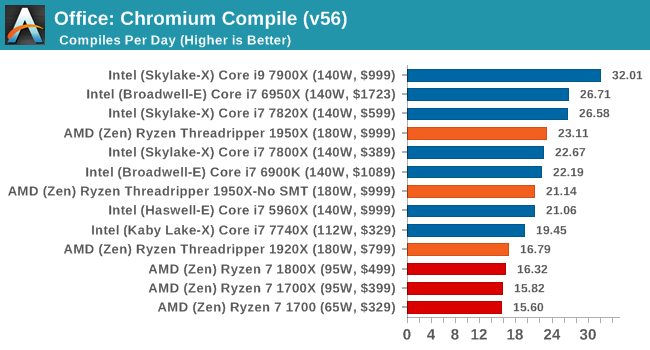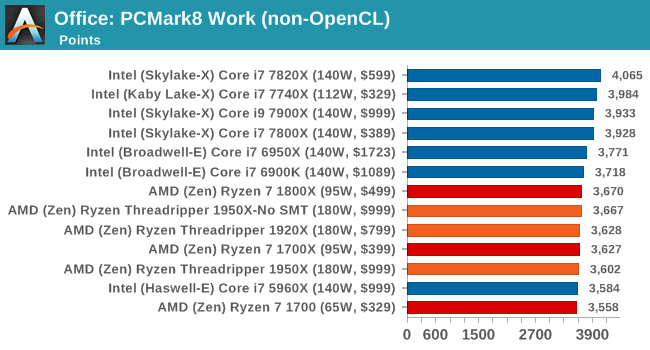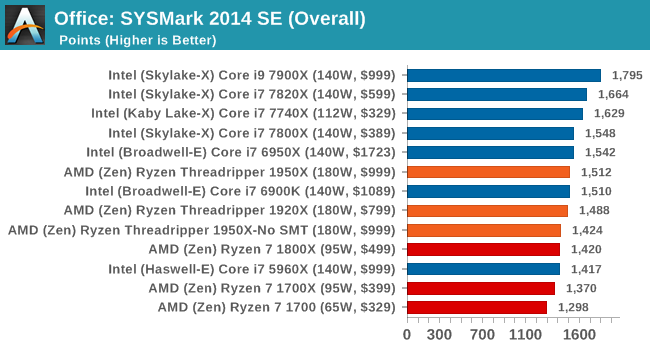The AMD Ryzen Threadripper 1950X and 1920X Review: CPUs on Steroids
by Ian Cutress on August 10, 2017 9:00 AM ESTCPU Office Tests
The office programs we use for benchmarking aren't specific programs per-se, but industry standard tests that hold weight with professionals. The goal of these tests is to use an array of software and techniques that a typical office user might encounter, such as video conferencing, document editing, architectural modeling, and so on and so forth.
All of our benchmark results can also be found in our benchmark engine, Bench.
Chromium Compile (v56)
Our new compilation test uses Windows 10 Pro, VS Community 2015.3 with the Win10 SDK to compile a nightly build of Chromium. We've fixed the test for a build in late March 2017, and we run a fresh full compile in our test. Compilation is the typical example given of a variable threaded workload - some of the compile and linking is linear, whereas other parts are multithreaded.

One of the interesting data points in our test is the Compile, and it is surprising to see the 1920X only just beat the Ryzen 7 chips. Because this test requires a lot of cross-core communication, the fewer cores per CCX there are, the worse the result. This is why the 1950X in SMT-off mode beats the 3 cores-per-CCX 1920X, along with lower latency memory support. We know that this test is not too keen on victim caches either, but it does seem that the 2MB per core ratio does well for the 1950X, and could explain the performance difference moving from 8 to 12 to 16 cores under the Zen microarchitecture.
PCMark8: link
Despite originally coming out in 2008/2009, Futuremark has maintained PCMark8 to remain relevant in 2017. On the scale of complicated tasks, PCMark focuses more on the low-to-mid range of professional workloads, making it a good indicator for what people consider 'office' work. We run the benchmark from the commandline in 'conventional' mode, meaning C++ over OpenCL, to remove the graphics card from the equation and focus purely on the CPU. PCMark8 offers Home, Work and Creative workloads, with some software tests shared and others unique to each benchmark set.


Strangely, PCMark 8's Creative test seems to be failing across the board. We're trying to narrow down the issue.
SYSmark 2014 SE: link
SYSmark is developed by Bapco, a consortium of industry CPU companies. The goal of SYSmark is to take stripped down versions of popular software, such as Photoshop and Onenote, and measure how long it takes to process certain tasks within that software. The end result is a score for each of the three segments (Office, Media, Data) as well as an overall score. Here a reference system (Core i3-6100, 4GB DDR3, 256GB SSD, Integrated HD 530 graphics) is used to provide a baseline score of 1000 in each test.
A note on context for these numbers. AMD left Bapco in the last two years, due to differences of opinion on how the benchmarking suites were chosen and AMD believed the tests are angled towards Intel processors and had optimizations to show bigger differences than what AMD felt was present. The following benchmarks are provided as data, but the conflict of opinion between the two companies on the validity of the benchmark is provided as context for the following numbers.











347 Comments
View All Comments
Lolimaster - Friday, August 11, 2017 - link
Sadly AMD was always the good fella even with known shills like anandtech.YazX_ - Thursday, August 10, 2017 - link
it is strange that you haven't mention data centers in the conclusion, this CPU will be selling like hot cakes for those, cloud computing and VMs.Ian Cutress - Thursday, August 10, 2017 - link
It's a consumer CPU, which is something AMD emphasized in our briefings and again when we asked them about where they are pitching the processors. If users want Zen for datacenters, EPYC exists. We have benchmarks for those too.mapesdhs - Friday, August 11, 2017 - link
It's a heck of a stretch to outright call it a consumer CPU when it has so many pro-type features such as ECC support. Sure it's aimed at consumers, but it's definitely aimed at prosumers aswell, and I'd be amazed if at least a few fully pro places didn't buy some, even if only to test.Beany2013 - Friday, August 11, 2017 - link
AMD have historically been pretty cool about ECC support - and professionals such as video and rendering types appreciate, as RAM wobbles on 24hr+ rendering workflows have one less thing to worry about.It's not that their subtly targetting server markets or owt, they just know that a substantial minority of their client base appreciate being able to utilise ECC memory without having to quadruple the cost of the base hardware, as you do with Intel stuff.
Notmyusualid - Saturday, August 12, 2017 - link
@ mapesdhsQuote "It's a heck of a stretch to outright call it a consumer CPU"
He didn't just say it was a consumer prouduct - AMD (the manufacturer, remember) TOLD him it was.
Thats called logic, that'll help you.
T1beriu - Thursday, August 10, 2017 - link
GTA V, you write "ASUS GTX 1060 Strix 6G Performance", but the charts say "GTX 1080".Ninhalem - Thursday, August 10, 2017 - link
I would like to see software like ANSYS Structures or ANSYS Fluent benchmarked, but after talking with ANSYS Hardware Support, they're still waiting to see how EPYC performs on base hardware. Building systems for ANSYS using Intel parts involves obscene amounts of money, so if you can save any money with the same amount of performance, a myriad amount of companies would be interested.Ian Cutress - Thursday, August 10, 2017 - link
I've been in contact with Ansys before to collaborate on a benchmark. They didn't want to get involved.mapesdhs - Thursday, August 10, 2017 - link
That's a pity, as I understand it ANSYS is a task that gobbles RAM by the truckload, it'd be an interesting use case for analysing memory/cache behaviour.Many years ago, one ANSYS user told me his ideal system would be single CPU with 1TB RAM.